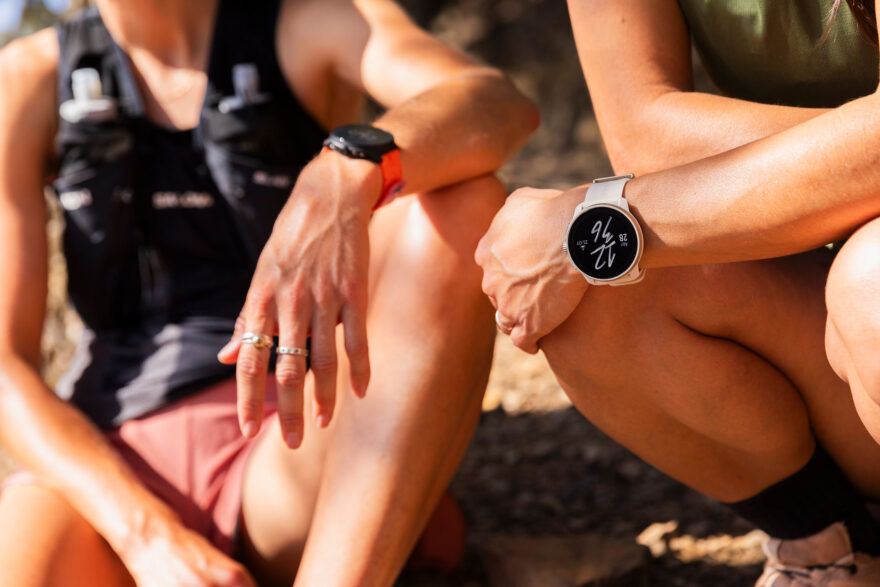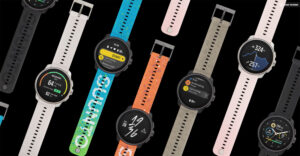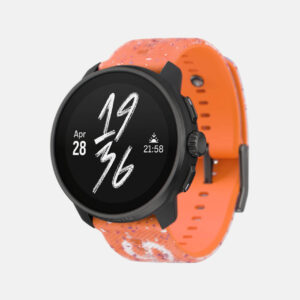
The Suunto Race S launched on June 25. (Image courtesy of Suunto)
The newly launched Suunto Race S delivers almost all of the bang of its larger counterpart but with a targeted appeal to runners, skiers, and other adventurers who have slimmer wrists or simply want a lighter-weight sport watch.
The Suunto Race S packs a 1.32-inch AMOLED display into a 45 mm case (compared to 1.43 inches in a 49 mm casing for the original Race), while maintaining the same screen resolution.
With Suunto having re-committed itself to the trail running community, which had long been its most ardent audience, the Race S seems well positioned to make further inroads there, along with the original Race version and the MIP-display Vertical, both of which have been popular with that segment since their launches in 2023.
These latest watches are helping Suunto “hit one of our targets for this year, which is first and foremost trail running,” said Dan Suher, Suunto’s sales director for the Americas. “That’s backed by a major investment in the UTMB World Series and in athletes like Courtney Dauwalter and now Zach Miller and Abby Hall. We are absolutely digging in both on the product and the marketing to gain that segment back.”

The six designs of the Suunto Race S. (Image courtesy of Suunto)
The launch of the Race S comes on the heels of a wild few days for the Finland-based brand: On June 18, Suunto released a new dive watch, the Suunto Ocean, which adds Vertical and Race features and styling to its already top-tier dive lineup. But then, only hours after the Ocean came out, MTV News reported that Suunto was laying off 76 workers from its nearly 300-person staff, including many longtime employees. In a translation provided by the5krunner, the reason was that “Suunto will transfer part of the production and part of the product development to China.”
While most Suunto products have a legacy of being made in Finland, the original Race notably was made in China, a feature that helped bring the price down significantly. Suher notes that moving forward, he expects that the products made for the European and American markets will be made in Finland, while other markets will have products made in China — he explains it as having dual production lines as a way to capitalize on consumer demands and supply chains.
“There’s always challenges when you’re dealing with international business, there’s lots of cultures in play,” Suher told ActionHub prior to the layoffs being announced. “We’ve got the U.S. culture; we’ve got Finnish Nordic culture, which is very rigid and process-oriented; and then there’s Chinese culture. But we’re still manufacturing the majority of our products in Finland, and the majority of the research and development is in Finland. But we also have added benefits on the supply chain side from having Liesheng ownership.”
Sure enough, samples of the Race S being released do show it back to being made in Finland, while still keeping an impressively competitive price point: The Race S comes in at $349, allowing the company to have the Race product line at the $349 (Race S), $449 (steel Race) and $549 (titanium Race) price points.
At least at launch, the Race S will only be available in a steel version.

The Suunto Race S is targeted toward people who have smaller wrists or simply want a lighter-weight watch. (Image courtesy of Suunto)
With this new product, Suunto has taken a step toward correcting one of the major complaints among users: the quality of the heart-rate sensor. The Race S has a new sensor with two added photodiodes on it, aiming to increase the accuracy of HR measurements, which factor into calculating workout exertion and recovery metrics.
“There’s also optical heart rate benefits in a smaller watch because it has a better fit to the wrist, to be able to get a better reading,” Suher said. “Inherently a smaller watch, all other things created equal, is going to be better with heart rate readings.”
While the biggest concern historically with an AMOLED display has been its functionality in direct sunlight, virtually all users and reviewers report that the Race lineup looks great in the sun and maintains much of the vibrancy wearers get at night or indoors. (Editor’s note: ActionHub anticipates writing an in-depth review of the Race S in a few weeks, after having time to do thorough testing. But for now, check out what DC Rainmaker had to say.)
“With Suunto Race S, you’ve got your companion for training and racing. The smaller and lighter design adds comfort, so you can focus on your sport, and enjoy using the watch anytime of the day,” said Daniel Das Bhowmik, head of product for Suunto.
The Race S includes maps, all-systems satellite settings and dual-frequency GPS tracking (utilizing L1 and L5 frequencies). Instead of sapphire glass, the Race S has adopted Gorilla glass, a feature that helps to keep the listed price within reach of more consumers.
Other key changes users will see in the Race S is the amount of battery life, which is understandably less since a smaller battery is needed to fit inside a smaller and thinner case size. Suunto’s latest testing puts the Race S at around 30 hours of GPS tracking on dual-frequency mode. (The original Race is listed at 40 hours in that same mode, but most people report getting closer to 45 or 50 hours, so Suunto is re-evaluating its spec sheet with that device.)
The 30 hours from the Race S compares favorably against AMOLED models from a brand like Garmin, which gets 19 hours from the Forerunner 965 in dual-band and 14 hours from the Forerunner 265.
For those wanting to go longer, the satellite settings can be customized for more battery hours — Suunto says the battery can last up to five days with GPS tracking while in the “Tour” battery mode on, though admittedly that’s a setting that few will take advantage of. The Endurance and Ultra modes, both of which take satellite readings at one-second intervals, are great and likely to be utilized often by folks spending time in the mountains or otherwise off-grid.

Image courtesy of Suunto
The watch comes with 95 sport modes built in, ranging from trail running and cycling to swimming and yoga, each equipped with carefully selected default data fields. It also has lots of useful apps available in the SuuntoPlus store. The Race S tracks training load, progress, and recovery, with metrics such as heart rate variability (HRV), which serves as an indicator of the balance within the autonomic nervous system and offers valuable insights into an individual’s overall health and stress levels.
The Race S also monitors sleep, as well as sleep stages, a feature that Suunto began supporting with in-house software starting with the original Race (as of the time of this writing, the sleep stage functionality hasn’t made its ways to older watches).
This watch will be available in six different looks at launch and is compatible with 22 mm straps.
“For the Race S we created a range of styles from subtle designs to vibrant racing looks. The small size makes the watch lightweight and comfortable to wear everyday and during long races,” said Mikko Ahlström, Suunto’s head of design. “It’s amazing how small we were able to make it without sacrificing performance.”
One of the best parts of Suunto products is the brand’s efforts toward sustainability. The Race S will be carbon offset with Verified Carbon Units, an initiative that involves planting coastal mangrove forests, which not only stabilize shorelines but also remove pollutants, improve water quality, and provide crucial nursery habitats for fisheries. Additionally, the Race S will have slim, minimalist packaging, using entirely recycled paper.
More details about the Race S will be made available after extensive hands-on testing is completed.
Ryan Tipps is Managing Editor for ActionHub. He lives along the Blue Ridge Mountains, is an avid hiker, backpacker and trail runner and has been a part of the wilderness search and rescue community since 2005.
 Your Privacy Choices
Your Privacy Choices